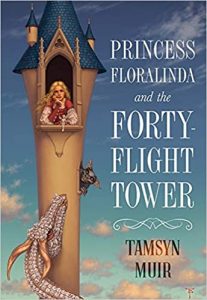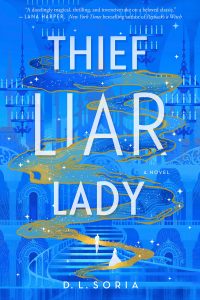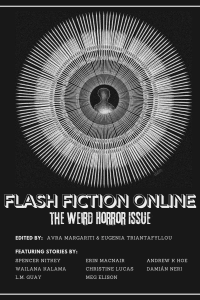Liz Bourke Reviews Princess Floralinda and the Forty-Flight Tower by Tamsyn Muir
 Princess Floralinda and the Forty-Flight Tower, Tamsyn Muir (Subterranean Press 978-159606-992-3, $40.00, 200pp, hc) November 2020. Cover by Tristan Elwell.
Princess Floralinda and the Forty-Flight Tower, Tamsyn Muir (Subterranean Press 978-159606-992-3, $40.00, 200pp, hc) November 2020. Cover by Tristan Elwell.
Tamsyn Muir’s Princess Floralinda and the Forty-Flight Tower did not leave me a happy reader. The author of Gideon the Ninth and Harrow the Ninth has, in this long novella from Subterranean Press, turned her attention from science fantasy and space necromancy to the fairy-tale-esque, in a story that draws on Rapunzel and folktale monsters to bring us a narrative of a princess who becomes an unrepentant monster.
Publishers Weekly used phrases like “the innocent romance of a children’s story” and “winsome enchantment” to describe it. That is one interpretation: the voice is certainly striking, with a calculatingly arch, mannered evocation of storybook style. But the more of Muir’s work I read, the more convinced I am that what I initially (in Gideon the Ninth) put down to coincidence is either a more general habit of mistaking cruelty for power (and the ability, or choice, to commit acts of cruelty as personal development); the inability to see cruelty for what it is; or the refusal to consider that cruelty has a moral weight: that it matters, and in more than a solipsistic fashion.
All that is to say that Floralinda and the Forty- Flight Tower, underneath the playfulness and arch style, is veined through with cruelty. It’s the kind of cruelty that doesn’t ask what it means to be a monster, and whether it is possible that monstrousness may be complicated, but instead satisfies itself with embracing monstrousness as a fulfilling exercise of personal power.
“This is a really commonplace cruelty for a thing like me,” the witch of Floralinda says, and cruelty as commonplace – ordinary, unremarkable, at times entirely purposeless and petty – is the hallmark of the following pages. Even love, here, is incapable of rising past selfishness.
From this you may divine that I did not much like Floralinda and the Forty-Flight Tower. My liking it or not is largely irrelevant: I have disliked many novels that were complex, well-executed examples of the craft. And on the surface, Floralinda and the Forty-Flight Tower is well executed: the sentences are well-crafted, the voice is vivid, and the pacing measures itself well against its length. But it’s about as deep as a puddle. Had it not been so wound about with cruelty, I might have judged it less harshly for its shallowness.
Floralinda is a princess. A storybook princess, fair-haired and beautiful, gently-raised and much more sheltered than any real princess could ever afford to be. Floralinda is taken by a witch and installed at the top of a 40-storey tower (one does rather wonder as to the architect and the builders). She will be freed only when someone – presumably, as is traditional, a prince – defeats the monsters on the other 39 floors. But at the base of the tower, first of all monsters, is a terrible dragon.
No prince can get past the first hurdle.
Floralinda, at first by accident, kills some of the monsters immediately below her. Then, with the reluctant aid of Cobweb, a fairy that Floralinda has trapped with her, Floralinda sets out to make it to the bottom of the tower. Getting to the bottom of the tower involves getting progressively better at killing on purpose, over the course of months.
Having made it to the base of the tower, Floralinda is no longer a princess. She is, as the witch says, “a monster – a rare and magnificent monster; perhaps even unique.” Floralinda will take the place of the dragon: other princesses will be installed at the top of the tower. The novella closes with Floralinda telling the captive princess that she wants “a f–-ing challenge,” and heading back to the bottom of the tower to wait. Devoid of solidarity and sympathy, Floralinda and the Forty-Flight Tower is a marvel of amoral, selfish whimsy: shallowly entertaining, but deeply f–-ing depressing.
But then, perhaps I’m biased: I don’t find monsters particularly interesting, unless they have a good reason to choose things that appear monstrous.
Liz Bourke is a cranky queer person who reads books. She holds a Ph.D in Classics from Trinity College, Dublin. Her first book, Sleeping With Monsters, a collection of reviews and criticism, is out now from Aqueduct Press. Find her at her blog, her Patreon, or Twitter. She supports the work of the Irish Refugee Council and the Abortion Rights Campaign.
This review and more like it in the October 2020 issue of Locus.
 While you are here, please take a moment to support Locus with a one-time or recurring donation. We rely on reader donations to keep the magazine and site going, and would like to keep the site paywall free, but WE NEED YOUR FINANCIAL SUPPORT to continue quality coverage of the science fiction and fantasy field.
While you are here, please take a moment to support Locus with a one-time or recurring donation. We rely on reader donations to keep the magazine and site going, and would like to keep the site paywall free, but WE NEED YOUR FINANCIAL SUPPORT to continue quality coverage of the science fiction and fantasy field.
©Locus Magazine. Copyrighted material may not be republished without permission of LSFF.








Floralinda is a villianness fantasy, not a hero fantasy or damsel-in-distress fantasy (which so many femme fantasy heroines at the end of the day are despite claiming to be grrl power). Muir clearly is aware of the immorality; Floralinda is distressed at many points because she understands it too. It’s humorous in the way movies like Trainstopping are. It’s funny in the way EMTs and nurses are, to take lessen the weight of the incredible burden they bear. On the surface Floralinda can be taken as a selfishly whimsical romp of violence and immorality, but it’s so much more than that.
Power doesn’t equal cruelty, but when lives are at stake, especially in fantasy settings, survival means you have to be ruthless. Floralinda doesn’t enjoy the killing itself. She never draws it out, doesn’t torture her opponenets to see them suffer. She executes them as efficiently as she can. What Floralinda enjoys is the satisfaction of knowing she is stronger and better, and will live to see another challenger. She feels the rush of having beat one level in a video game, knowing she will have to face another, more challenging enemy. She enjoys it because it’s what the world made her do, when it gave up on her. That’s the real cruelty of the story.
Now, I cry at every kids’ movie and personify and feel bad for inanimate objects. But I don’t think it’s monstrous to love a monster. And I don’t think, in Floralinda’s world, at least, it’s bad to be a monster. For in Floralinda’s world, you have to be something. If you’re not a princess, you’re a queen, a witch, or a nobody. Princess and Princesses are apparently a dime-a-dozen. Why not be a monster, and a unique one at that?
Whoever at Publishers Weekly said “the innocent romance of a children’s story” about Floralinda is off their rocker.
I mostly agree with your comment, and think that it’s quite more engaged with the themes of the book than the original review. As I see it, the book is largely a commentary on the inherent cruelty of fairy tales and their tropes. However, I would argue that Floralinda truly is something of a monster by the end of the book, given that she becomes instrumental in perpetuating the cycle of suffering, with no apparent empathy towards the princess now stuck at the top. This is, indeed, kind of f—ing depressing if you really think about it.
That being said, I still think it’s a very appropriate ending for the book. An unambiguously feel-good ending probably would have betrayed the themes of the story and felt cheap. Muir had some mercy with Cobweb coming back. That’s most of the way toward a happy ending.